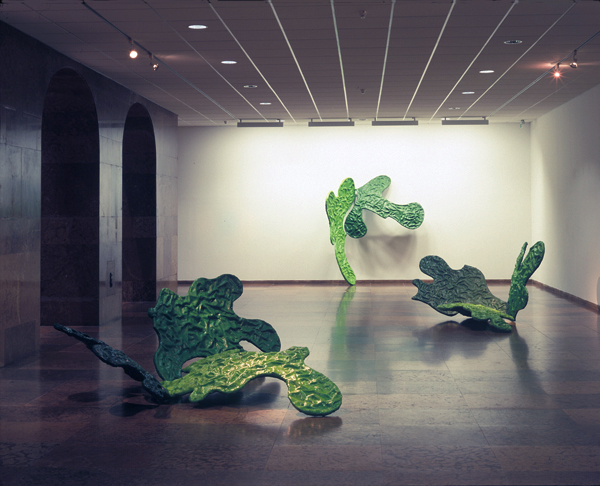“Military camouflage – imitated nature. Its markings are the various shades of our climate and vegetation, from yellow through to brown. The forms – as is the nature of camouflage – imitate foliage, leaves, the shadows cast by the leaves, or the traces of sunlight filtering through the foliage. In Körösényi’s work, these arched, lobed, rounded markings have become independent sculptures; their presence marks and brings into contact the various points of the space. The viewer prays a vita role, in actual fact he is the contact point that brings about the co-relation (constellation) of the sculptures. They can be approached from any angle, encountered anywhere. They climb up the walls or lie on the floor, stand on the ground or the stairs alone or joined together. They are infinitely variable, a change in position has a completely different effect, they can be used again and again without us recognising them. Entwined together they could make a miniature forest in a beautiful baroque hall, but they also have the potential to return to Nature as a continuation of it and melt together and yet still retain their separate identity.”
Ildikó Nagy: Seven Contemporary Hungarian Sculptors. Catalogue 1997
”We stand before the creations of Tamás Körösényi, works which are some of the most characteristic examples of the style that made Körösényi a name. These elementary forms, similar to leaves or lichen, someway between camouflage and botany, really began to take on a spatial autonomy from 1996 onwards. As though these objects made from papier-mâché and strengthened with metal rods were standing before us as flexible components of another second Nature. In the artist’s home these whimsical changeable forms, reminding us of certain configurations of Arp, stand amongst the plants and armchairs. In his exhibition in Biron Castle, his astounding “articulations” were regarded as stealthy and irresistible plant fantasy invaders of the classical historical world. Since 1996, parallel to this, Körösényi has experimented in other ways with liana creeper-like bundles made from wire and covered in papier-mâché, their ethereal forms suggesting a passionate interest in the work of the sculptor Giacometti.”
Pierre Restany: Hungary is not behind the times. In: Seven Contemporary Hungarian Sculptors. Catalogue 1997
Born in Budapest in 1953, Tamás Körösényi received his degree in 1975 from the Hungarian Academy of Fine Arts, Budapest, where he is a professor of sculpture presently.

